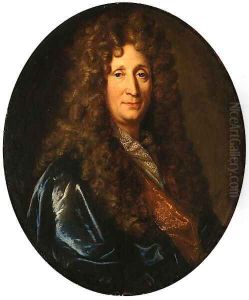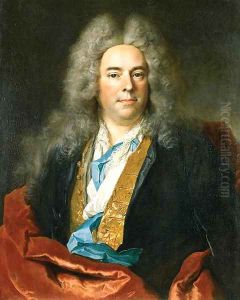Nicolas De Largillire Paintings
Nicolas de Largillierre was a prominent French painter born in Paris on October 10, 1656. His work is most often associated with the Baroque period, and he is celebrated for his portraiture, capturing the opulence and precision of the French nobility and bourgeoisie with vivid realism and rich color. Largillierre's talent was evident from an early age, leading him to an apprenticeship with the historical painter Antoine Goubeau in Antwerp, which was then a part of the Spanish Netherlands. This early Flemish influence would remain a significant element in his style, particularly in his use of color and texture.
Largillierre's career took a decisive turn after he moved to England in 1674, where he worked under the tutelage of the famous portraitist Sir Peter Lely. This experience not only honed his skills in portraiture but also expanded his understanding of the English aristocracy's tastes, an insight that would later serve him well upon his return to France. By 1680, Largillierre had established himself in Paris and became a member of the prestigious Royal Academy of Painting and Sculpture. His reputation grew rapidly, and he was soon sought after by the French elite for his portraits.
Over the years, Largillierre's style evolved, reflecting the changing tastes of his clientele and the influence of other artists such as Hyacinthe Rigaud and Antoine Watteau. Despite this evolution, his work remained characterized by its detailed representation of textures, especially in fabrics and accessories, and the lively, almost theatrical presentation of his subjects. This was a departure from the more reserved and formal portraiture of his predecessors, making his work highly prized for its vibrancy and expressiveness.
Beyond portraiture, Largillierre also excelled in still life and religious painting, though these genres constitute a smaller portion of his oeuvre. His still lifes, in particular, are noted for their meticulous detail and the rich, almost tactile quality of their subjects. In his later years, Largillierre became involved in the administration of the Royal Academy, serving as its rector and contributing to the education of the next generation of French artists. Nicolas de Largillierre died in Paris on March 20, 1746, leaving behind a legacy as one of the most influential and prolific portraitists of the French Baroque era. His works continue to be celebrated for their artistic merit and as a vivid historical record of his time.

